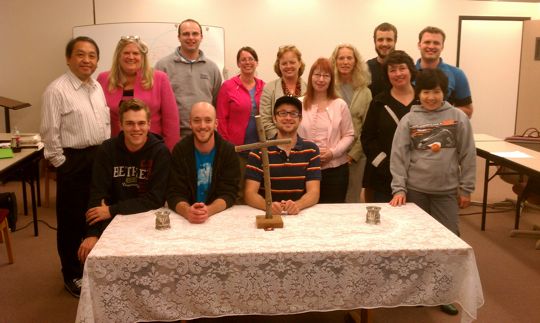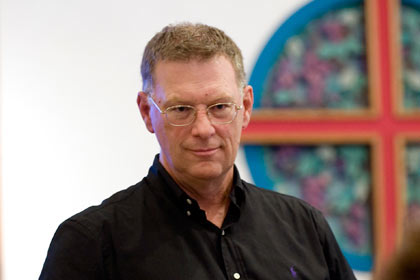
Members of the Bethel San Diego Spring 2011 Class on Spirituality & Prayer
Zondervan Q&A with Glen Scorgie, general editor, Dictionary of Christian Spirituality
Congratulations on the publication of the Dictionary of Christian Spirituality. In terms of the writing and editing, what kind of work hours do you think the project represents?
The Dictionary project took four years of focused effort. The workload ebbed and flowed across these years, but I’d estimate it involved 10-20 hours a week on average. The other editors and I managed to keep organized with an Excel spreadsheet; each entry involved 17-19 discreet steps.
Writing for this book was certainly not a sensible strategy for getting rich. Sometimes I cajoled reluctant contributors to join the company of the cheerfully exploited. Usually that phrase won them over. But I must say the whole project, from start to finish, was an absolute delight. For one thing, the DCS team got to interact with some of the finest people on the planet. I’ve often said that without the excuse of this project, how else would I get up the nerve to bother Eugene Peterson in his cabin up in Montana, or Dallas Willard or J. I. Packer?
How would you distinguish the DCS from other reference materials available for studying Christian spirituality?
Some people may be surprised to learn that there are a number of other reference works on Christian spirituality already available to English readers. All the contributors and I have the highest regard for these works and the people who put them together. At the same time we felt that there was a need for one that would offer a discerning orientation to the wealth of ecumenical resources available today while still highlighting the distinct heritage and core grace-centered values of classic evangelical spirituality. We have also tried to craft a substantive volume unique in its level of biblical engagement, its accessibility and its practicality. Finally, we are very pleased that the publisher managed to keep the price down so that the book will be within reach of most students, pastors and other hardworking folk.
Readers will notice that the first section of the dictionary is not entries per se but a collection of introductory articles. Why did you choose to start this way, and how did you decide which topics to cover in the opening chapters?
You’re right. The dictionary starts with 34 integrative essays, and after that moves into nearly 700 shorter, alphabetized entries. The short entries are important, but from personal experience we know that these “data bytes” by themselves can generate an unsatisfying sense of unorganized information overload. The integrative essays are designed to help readers see the forest and not just the trees—to grasp the larger perspectives that help hold the otherwise chaotic details together. The essays address what we believe are some of the “big issues” and “cutting edge topics” in Christian spirituality today.
The dictionary entries cover the books of the Bible, major Christian traditions, major players in the landscape of Christian spirituality, and major Christian spiritual practices. Have I missed anything? How did you decide what to include and what you didn’t have room for?
You haven’t missed much! I would only add that we have also tried to address some key doctrines (like the Holy Spirit), different periods in history (like the Middle Ages), interfaces with cognate disciplines (like psychology and therapy), and important topics (like mysticism).
The last consideration for us what this: Who have been the key shapers of evangelical spirituality through the years? Often these people have been overlooked in other reference works; we tried to make sure that the key influencers of global evangelical spirituality were at least acknowledged in this volume.
It was very challenging to decide what to leave in and what to leave out. First, we tried to address the main questions students of Christian spirituality tend to ask. Second, we selected topics and persons of historical significance and influence. Third, we prioritized entries that we felt contained insights or perspectives that might still be useful today—even if their use was only as a cautionary tale.
When it came time to assign these articles, we encouraged contributors to think about the practical relevance of their entries to spiritual life today. In my judgment the wisdom with which so many of them achieved this is one of the finest features of the volume.
Do you have any “favorite” entries?
I do have some favorites, actually. It is hazardous to mention any, of course, because of the implied slight on the rest. But my special favorites include the little entry on Benediction, by our dear friend Bob Rakestraw, who suffers terribly from heart disease near the end of life, but has chosen to bless rather than whine to his last breath in this life.
They also include the essay on the Holy Spirit, which the late Clark Pinnock was unable to finish on his own. I reviewed it when news of his death reached me. Its last sentence describes the fellowship of the Holy Spirit as “that exquisite foretaste of the eternal dance of reciprocating delight.” Tears came to my eyes when I realized that Clark no longer must settle for foretastes. I like the essay Steven Guthrie wrote on Music and the Arts; it has a beauty to it that is especially fitting for the subject it addresses. And I rejoice in the aesthetic passion of Loren and Mary-Ruth Wilkinson’s treatment of spirituality in relation to creation—surely one of the most urgent issues of our time.
At a personal level I feel special paternal pride in the articles my daughter Sarah wrote; it is a great joy to see her talent and poetic soul emerging. So you see—most of my assessments of “favorite” have a relational basis, which is precisely what we are trying to say about spirituality generally. It too is fundamentally relational.
What new things did you learn as the editor?
At the outset Gordon Smith advised me not to underestimate the potential of younger, emerging scholars. It was sage advice. We were honored to have so many “big names” contribute, but were amazed at the quality and depth of insight of so many younger scholars who are less well-known today but very promising individuals indeed. They are signs of hope, evidence that the Spirit has not abandoned the church.
As a teacher, how do you envision the Dictionary of Christian Spirituality being used in the classroom? In research?
This work can right away be added to a list of recommended resources for an undergraduate or graduate course in Christian spirituality or spiritual theology. But with its 34 essays it can also function as a textbook for such courses. Chapters, with relevant articles added, can be assigned as weekly reading. The publisher is presently developing a “suite” of additional resources (available free of charge online) for professors who may choose to use the volume as a textbook.
The Dictionary of Christian Spirituality is also a sensible first stop for students who are doing research and writing papers on topics related to spirituality. The entries are compact distillations of the most important facts or considerations on their various subjects; by investing just a few minutes the reader can acquire a reliable overview. Moreover, most of the articles and essays conclude with some carefully chosen suggestions for further reading; these are excellent points of entry for research on these matters, and the cross-references to related topics are also helpful.
One of the chronic problems in ministerial training is that a curriculum consists of many narrow “silos” of instruction. What we need is more interdisciplinary integration, so that students are able to make meaningful connections between the parts of their training. It is always sad when Christian spirituality becomes a mere course in a curriculum, rather than an energizing power infusing the whole. Every instructor can profitably consult Dictionary of Christian Spirituality as they develop strategies for incorporating a meaningful dimension of spirituality and spiritual formation into their teaching practices.
Does the Dictionary of Christian Spirituality belong in the church as well? How will it be helpful there?
It belongs in congregational settings too! So many of the practical, everyday questions about the Christian life that people raise with their pastors are addressed in this volume. It also provides reliable information when they have questions about Mormon neighbors or a friend involved in something like Scientology.
The book can be of help to entire pastoral staffs. There are entries on adolescent and children’s spirituality, as well as topics like personal devotions, evangelism, small groups and worship. Unless we are attuned to the spiritual dynamics of these sorts of activities, they can devolve into mere programs. We also need heroes—young people in particular need their inspirational examples—and this volume provides profiles of many, many giants of the faith.
Hopefully many evangelical churches will purchase at least one copy for their church library or resource center, so that everyone in the church can have access to it.

Comments are closed.